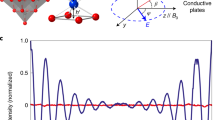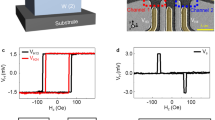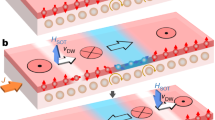Abstract
Spin-based computing schemes could enable new functionalities beyond those of charge-based approaches1,2,3,4,5,6. Examples include nanomagnetic logic, where information can be processed using dipole coupled nanomagnets7,8,9,10,11,12,13,14, as demonstrated by multi-bit computing gates8,13. One fundamental benefit of using magnets is the possibility of a significant reduction in the energy per bit compared with conventional transistors1,8,14,15. However, so far, practical implementations of nanomagnetic logic have been limited by the necessity to apply a magnetic field for clocking8,11. Although the energy associated with magnetic switching itself could be very small, the energy necessary to generate the magnetic field renders the overall logic scheme uncompetitive when compared with complementary metal–oxide–semiconductor (CMOS) counterparts. Here, we demonstrate a nanomagnetic logic scheme at room temperature where the necessity for using a magnetic field clock can be completely removed by using spin–orbit torques16,17,18,19,20,21,22. We construct a chain of three perpendicularly polarized CoFeB nanomagnets on top of a tantalum wire and show that an unpolarized current flowing through the wire can ‘clock’ the perpendicular magnetization to a metastable state. An input magnet can then drive the nanomagnetic chain deterministically to one of two dipole-coupled states, ‘2 up 1 down’ or ‘2 down 1 up’, depending on its own polarization. Thus, information can flow along the chain, dictated by the input magnet and clocked solely by a charge current in tantalum, without any magnetic field. A three to four order of magnitude reduction in energy dissipation is expected for our scheme when compared with state-of-the-art nanomagnetic logic.
This is a preview of subscription content, access via your institution
Access options
Subscribe to this journal
Receive 12 print issues and online access
$259.00 per year
only $21.58 per issue
Buy this article
- Purchase on Springer Link
- Instant access to full article PDF
Prices may be subject to local taxes which are calculated during checkout




Similar content being viewed by others
References
Salahuddin, S. & Datta, S. Interacting systems for self-correcting low power switching. Appl. Phys. Lett. 90, 093503 (2007).
Behin-Aein, B., Datta, D., Salahuddin, S. & Datta, S. Proposal for an all-spin logic device with built-in memory. Nature Nanotech. 5, 266–270 (2010).
Bandyopadhyay, S. & Cahay, M. Introduction to Spintronics (CRC, 2008).
Nikonov, D. E., Bourianoff G. I. & Ghani, T. Proposal of a spin torque majority gate logic. IEEE Electron. Dev. Lett. 32, 1128–1130 (2011).
Ikeda, S. et al. Magnetic tunnel junctions for spintronic memories and beyond. IEEE Trans. Electron. Dev. 54, 991–1002 (2007).
Ohno, H., Endoh, T., Hanyu, T., Naoki, K. & Ikeda, S. Magnetic tunnel junction for nonvolatile CMOS logic. IEEE IEDM Tech. Digest 2010, 218–221 (2010).
Cowburn, R. P. & Welland, M. E. Room temperature magnetic quantum cellular automata. Science 287, 1466–1468 (2000).
Imre, A. et al. Majority logic gate for magnetic quantum-dot cellular automata. Science 311, 205–208 (2006).
Atulasimha, J. & Bandyopadhyay, S. Bennett clocking of nanomagnetic logic using multiferroic single-domain nanomagnets. Appl. Phys. Lett. 97, 173105 (2010).
Carlton, D. B., Emley, N. C., Tuchfeld, E. & Bokor, J. Simulation studies of nanomagnet-based logic architecture. Nano Lett. 8, 4173–4178 (2008).
Alam, M. T. et al. On-chip clocking of nanomagnetic logic lines and gates. IEEE Trans. Nanotechnol. 11, 273–286 (2012).
Ju, X. et al. Nanomagnetic logic from partially irradiated Co/Pt nanomagnets. IEEE Trans. Nanotechnol. 11, 97–104 (2012).
Breitkreutz, S. et al. Majority gate for nanomagnetic logic with perpendicular magnetic anisotropy. IEEE Trans. Magn. 48, 4336–4339 (2012).
Lambson, B., Carlton, D. & Bokor, J. Exploring the thermodynamic limits of computation in intergrated systems: magnetic memory, nanomagnetic logic, and the Landauer limit. Phys. Rev. Lett. 107, 010604 (2011).
Roy, K., Bandyopadhyay, S. & Atulasimha, J. Hybrid spintronics and straintronics: a magnetic technology for ultra low power energy computing and signal processing. Appl. Phys. Lett. 99, 063108 (2011).
Liu, L. et al. Spin–torque switching with the giant spin Hall effect of tantalum. Science 336, 555–558 (2012).
Liu, L., Lee, O. J., Gudmundsen, T. J., Ralph, D. C. & Buhrman, R. A. Current-induced switching of perpendicularly magnetized magnetic layers using spin torque from the spin Hall effect. Phys. Rev. Lett. 109, 096602 (2012).
Haazen, P. P. J. et al. Domain wall depinning governed by the spin Hall effect. Nature Mater. 12, 299–303 (2013).
Miron, I. M. et al. Current-driven spin torque induced by the Rashba effect in a ferromagnetic metal layer. Nature Mater. 9, 230–234 (2010).
Miron, I. M. et al. Perpendicular switching of a single ferromagnetic layer induced by in-plane current injection. Nature 476, 189–193 (2011).
Suzuki, T. et al. Current-induced effective field in perpendicularly magnetized Ta/CoFeB/MgO wire. Appl. Phys. Lett. 98, 142505 (2011).
Kim, J. et al. Layer thickness dependence of the current induced effective field vector in Ta/CoFeB/MgO. Nature Mater. 12, 240–245 (2013).
Hirsch, J. E. Spin Hall effect. Phys. Rev. Lett. 83, 1834–1837 (1999).
Ikeda, S. et al. A perpendicular anisotropy CoFeB–MgO magnetic tunnel junction. Nature Mater. 9, 721–724 (2010).
Bhowmik, D., You, L. & Salahuddin, S. Possible route to low current, high speed, dynamic switching in a perpendicular anisotropy CoFeB–MgO junction using spin Hall effect of Ta. IEEE IEDM Tech. Digest 2012, 29.7.1–29.7.4 (2012).
Nagaosa, N., Sinova, J., Onoda, S., MacDonald, A. H. & Ong, N. P. Anomalous Hall effect. Rev. Mod. Phys. 82, 1539–1592 (2010).
Alexandrou, M. et al. Spatial sensitivity mapping of Hall crosses using patterned magnetic nanostructures. J. Appl. Phys. 108, 043920 (2010).
Carlton, D. B. et al. Investigation of defects and errors in nanomagnetic logic circuits. IEEE Trans. Nanotechnol. 11, 760–762 (2012).
Nikonov, D. E. & Young, I. Overview of beyond-CMOS devices and a uniform methodology for their benchmarking. Proc. IEEE http://dx.doi.org/10.1109/JPROC.2013.2252317 (2013).
Niimi, Y. et. al. Giant spin Hall effect induced by skew scattering from bismuth impurities inside thin film CuBi alloys. Phys. Rev. Lett. 109, 156602 (2012).
Acknowledgements
The authors thank E. Chen and X. Tang of Grandis Corporation for help with material preparation, and D. Nikonov and J. Bokor for valuable discussions. This work was supported in part by the Defense Advance Research Projects Agency Non-Volatile Logic Program, the National Science Foundation Center for Energy Efficient Electronics Science Centre at Berkeley, and the Semiconductor Research Corporation Western Institute of Nanoelectronics centre.
Author information
Authors and Affiliations
Contributions
L.Y. fabricated the devices. D.B. and L.Y. performed measurements. S.S. conceived and supervised the overall project. All authors discussed and analysed data and participated in writing the manuscript.
Corresponding author
Ethics declarations
Competing interests
The authors declare no competing financial interests.
Supplementary information
Supplementary information
Supplementary Information (PDF 2162 kb)
Rights and permissions
About this article
Cite this article
Bhowmik, D., You, L. & Salahuddin, S. Spin Hall effect clocking of nanomagnetic logic without a magnetic field. Nature Nanotech 9, 59–63 (2014). https://doi.org/10.1038/nnano.2013.241
Received:
Accepted:
Published:
Issue Date:
DOI: https://doi.org/10.1038/nnano.2013.241
This article is cited by
-
Evaluating nanomagnetic logic circuit layouts using different clock schemes
Analog Integrated Circuits and Signal Processing (2021)
-
Frequency-domain ultrafast passive logic: NOT and XNOR gates
Nature Communications (2020)
-
Hardware implementation of Bayesian network building blocks with stochastic spintronic devices
Scientific Reports (2020)
-
Voltage-induced strain clocking of nanomagnets with perpendicular magnetic anisotropies
Scientific Reports (2019)
-
Spin-torque devices with hard axis initialization as Stochastic Binary Neurons
Scientific Reports (2018)



